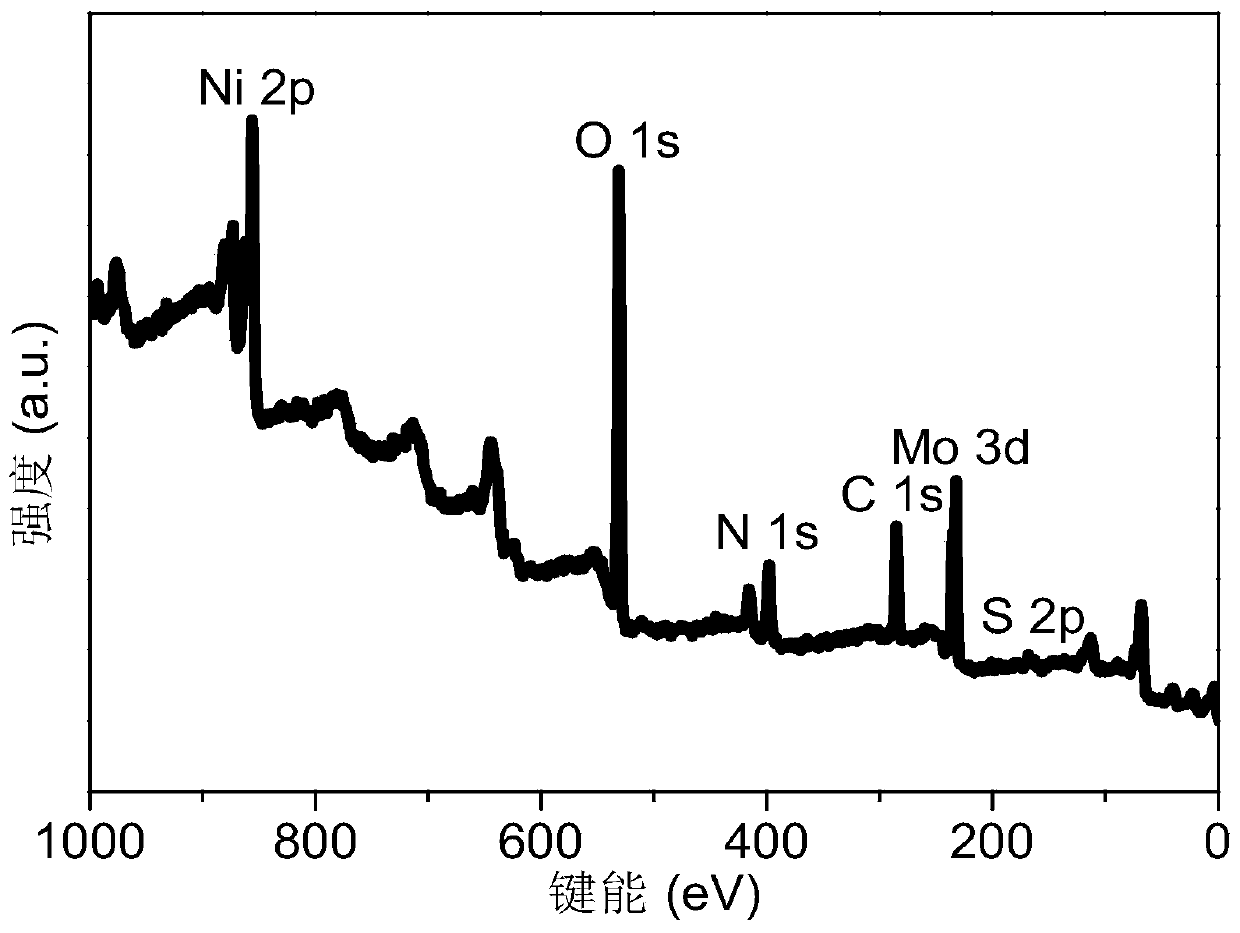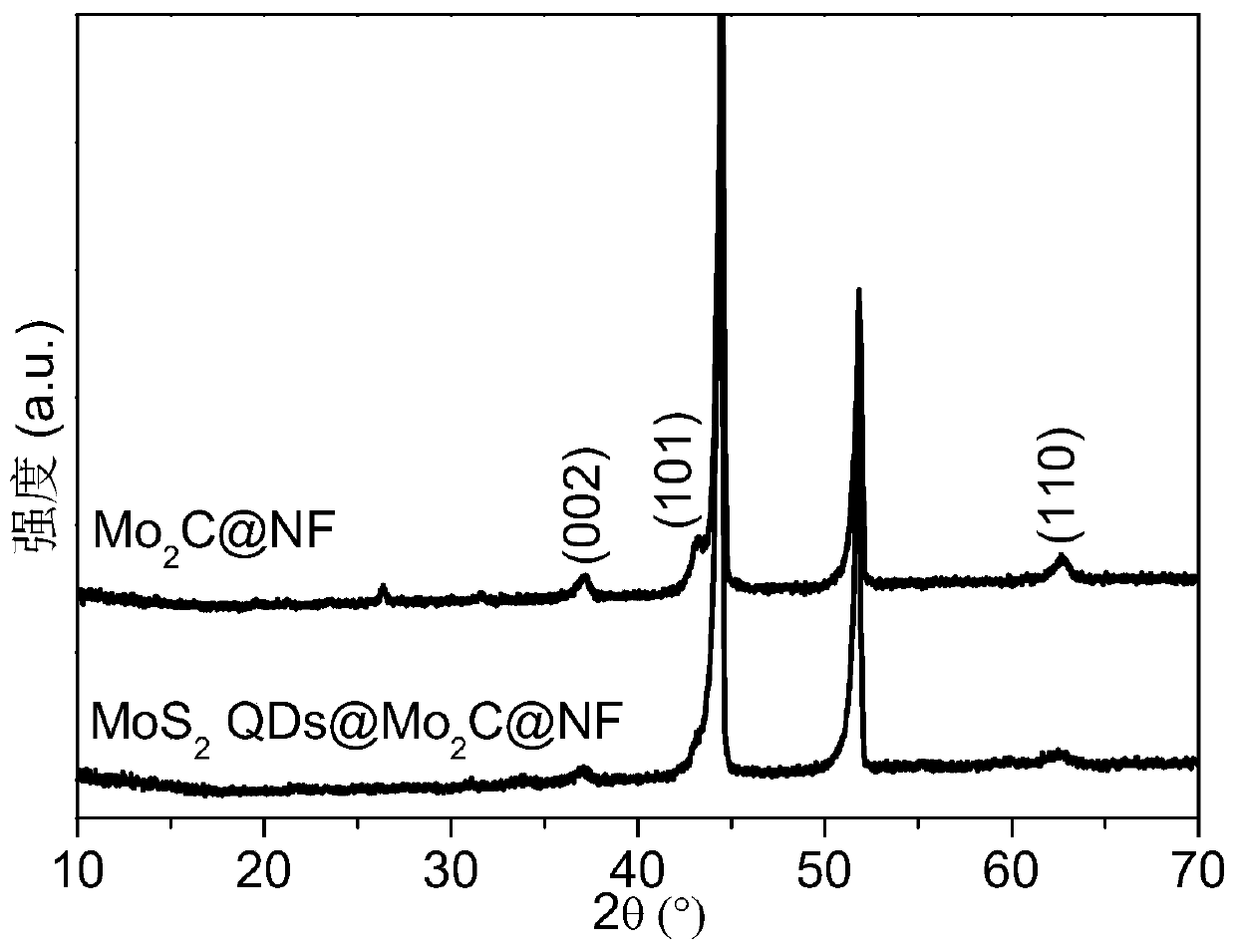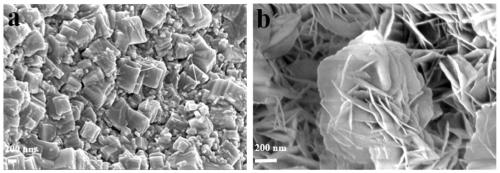Molybdenum disulfide quantum dot modified molybdenum carbide/foamed nickel composite material, preparation method and application of the composite material in electrocatalytic oxygen evolution
A technology of molybdenum disulfide and composite materials, applied in catalyst activation/preparation, metal/metal oxide/metal hydroxide catalysts, chemical instruments and methods, etc., which can solve complex preparation and few researches on oxygen evolution reaction , loss of catalytic activity and other issues, to achieve the effect of large specific surface area, ensuring electrolyte penetration, and small static contact angle
- Summary
- Abstract
- Description
- Claims
- Application Information
AI Technical Summary
Problems solved by technology
Method used
Image
Examples
Embodiment 1
[0050] A molybdenum carbide / nickel foam composite material modified by molybdenum disulfide quantum dots, including molybdenum carbide and nickel foam, molybdenum carbide supported on the nickel foam to form a molybdenum carbide / nickel foam composite material, molybdenum carbide / nickel foam composite material surface growth There are molybdenum disulfide quantum dots.
[0051] In this embodiment, the mass ratio of molybdenum disulfide quantum dots to molybdenum carbide / nickel foam composite is 1.0%; the mass ratio of molybdenum carbide to nickel foam in the molybdenum carbide / nickel foam composite is 1.5%.
[0052] In this embodiment, the aggregation morphology of the molybdenum disulfide quantum dots grown on the surface of the molybdenum carbide / nickel foam composite material is flake-like; the average particle size of the molybdenum disulfide quantum dots is 4.75 nm. Molybdenum carbide has a block structure and is a cubic particle; the average particle size of molybdenum ca...
Embodiment 2
[0073] A molybdenum carbide / nickel foam composite material modified by molybdenum disulfide quantum dots is basically the same as in Example 1, the only difference being: the mass ratio of molybdenum carbide and nickel foam in the molybdenum carbide / nickel foam composite material used in Example 2 was 1.2%.
[0074] A preparation method of molybdenum carbide / nickel foam composite material modified by molybdenum disulfide quantum dots in the above-mentioned present embodiment is basically the same as that of embodiment 1, the only difference being that in the preparation method of embodiment 2, the molybdenum acid used The ammonium / trisodium citrate aqueous solution contained 0.1 mmol of ammonium molybdate and 0.1 mmol of trisodium citrate.
[0075] The molybdenum carbide / nickel foam composite material and molybdenum carbide / nickel foam composite material modified by molybdenum disulfide quantum dots prepared above were used as working electrodes for electrocatalytic oxygen evo...
Embodiment 3
[0078] A molybdenum carbide / nickel foam composite material modified by molybdenum disulfide quantum dots is basically the same as Example 1, the only difference being: the mass ratio of molybdenum carbide and nickel foam in the molybdenum carbide / nickel foam composite material used in Example 3 was 1.8%.
[0079] A kind of preparation method of molybdenum carbide / nickel foam composite material modified by molybdenum disulfide quantum dots in the above-mentioned present embodiment is basically the same as embodiment 1, the difference is only: in the preparation method of embodiment 3, the molybdenum acid used The ammonium / trisodium citrate aqueous solution contained 0.3 mmol of ammonium molybdate and 0.1 mmol of trisodium citrate.
[0080] The molybdenum carbide / nickel foam composite material and molybdenum carbide / nickel foam composite material modified by molybdenum disulfide quantum dots prepared above were used as working electrodes for electrocatalytic oxygen evolution, an...
PUM
| Property | Measurement | Unit |
|---|---|---|
| particle size | aaaaa | aaaaa |
| particle size | aaaaa | aaaaa |
| particle size | aaaaa | aaaaa |
Abstract
Description
Claims
Application Information
 Login to View More
Login to View More - R&D
- Intellectual Property
- Life Sciences
- Materials
- Tech Scout
- Unparalleled Data Quality
- Higher Quality Content
- 60% Fewer Hallucinations
Browse by: Latest US Patents, China's latest patents, Technical Efficacy Thesaurus, Application Domain, Technology Topic, Popular Technical Reports.
© 2025 PatSnap. All rights reserved.Legal|Privacy policy|Modern Slavery Act Transparency Statement|Sitemap|About US| Contact US: help@patsnap.com



